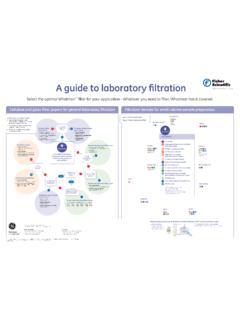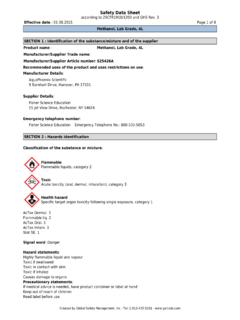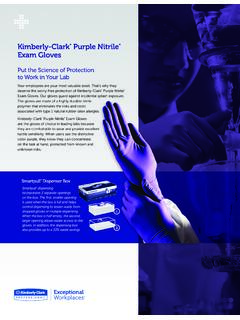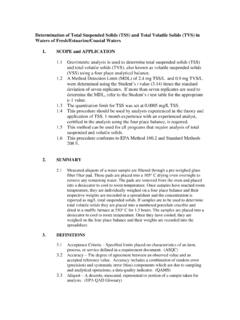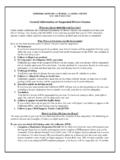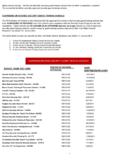Transcription of APHA Total Suspended Solids Procedure White Paper
1 Standard Operating Procedure for: Total Suspended Solids ID: TSSolids Revision: 2 May 2007 Page 2 of 11 Table of Contents 1 Identification of the test method .. 3 2 Applicable matrix or matrices: .. 3 3 Detection Limit .. 3 4 Scope of the test method .. 3 5 Summary of test 3 6 Definitions .. 3 7 Interferences .. 3 8 Health and safety .. 4 9 Personnel qualifications .. 4 10 Equipment and supplies .. 4 11 Reagents and standards .. 4 12 Sample collection, preservation, shipment and storage .. 4 13 Quality control .. 5 14 Calibration and standardization .. 6 15 Procedure .. 6 16 Data acquisition, calculations, and reporting.
2 8 17 Computer hardware and software .. 8 18 Method performance .. 8 19 Pollution prevention .. 9 20 Data assessment and acceptable criteria for quality control measures .. 9 21 Corrective actions for out-of-control or unacceptable data .. 9 22 Waste management .. 9 23 References .. 9 24 Tables, diagrams, flowcharts and validation data .. 10 25 Bench sheet .. 11 ID: TSSolids Revision: 2 May 2007 Page 3 of 11 1 Identification of the test method Determination of Total Suspended Solids 2 Applicable matrix or matrices: This method is suitable for the determination of Solids in potable and surface waters and wastewaters with Total Suspended Solids (TSS) of up to 20,000 mg/L.
3 3 Detection Limit The desired detection limit for this method is mg/L for a 1-L sample. 4 5 6 Scope of the test method This standard operating Procedure provides laboratory personnel with guidance on the Procedure for determining TSS. This method is limited to the determination of TSS in water samples collected from natural bodies of water containing TSS of < 20,000 mg/L. Summary of test method The Procedure described here follows Standard Methods (2005), 2540D and EPA (1983) Method (Residue, non-filterable). A well-mixed, measured volume of a water sample is filtered through a pre-weighed glass fiber filter.
4 The filter is heated to constant mass at 104 1 C and then weighed. The mass increase divided by the water volume filtered is equal to the TSS in mg/L. Definitions Analytical batch: The set of samples processed at the same time Laboratory reagent blank (LRB): An aliquot of deionized water treated as a sample in all aspects, except that it is not taken to the sampling site. The purpose is to determine if the analytes or interferences are present in the laboratory environment, the reagents, or the apparatus. Laboratory duplicate (LD): Two aliquots of the same environmental sample treated identically throughout a laboratory analytical Procedure .
5 Analysis of laboratory duplicates indicates precision associated with laboratory procedures but not with sample collection, preservation or storage procedures. Method detection limit (MDL) -- The lowest level at which an analyte can be detected with 99 percent confidence that the analyte concentration is greater than zero. 7 Interferences It is recognized that TSS measurements may include both positive errors (occluded water and waters of crystallization) and negative errors (decomposition and volatilization of minerals such as carbonates, as well as loss of Solids that are small enough to pass through the filter).
6 See SM, 2540 , , and for further discussion of interferences for this method. ID: TSSolids Revision: 2 May 2007 Page 4 of 11 8 Health and safety The analysis involves handling of freshwater samples that may contain live microorganisms and therefore pose some threat of infection. Laboratory personnel who are routinely exposed to such water samples are encouraged to protect themselves from water borne illnesses by wearing clean disposable gloves and washing their hands frequently. This analytical Procedure uses a vacuum pump for the filtration steps. There is a risk of implosion under some circumstances.
7 The analyst should ensure that the receiving flask is free from cracks or other imperfections. 9 10 Personnel qualifications Laboratory and field personnel shall have a working knowledge of this analytical Procedure and will have received training from an associate knowledgeable of the proper sample analysis procedures. Prior to the first batch of sample analyses, the analyst will complete a demonstration of capability exercise as described below in the Quality control section. Equipment and supplies Filters, Glass microfiber: 47 mm diameter, m nominal pore size, such as Whatman 934-AH (catalog number: 1827 047) or equivalent Filtration apparatus 1-L or 4-L receiving flaskc.
8 Filter funnel manifold, 3 filter funnels 300 tubing, inside Drying oven adjusted to 104 1 C. Aluminum weighing dishes (or equivalent). Analytical balance capable of reading to mg. 11 Reagents and standards Deionized water (DI): water that has been passed through a purification system ( , the Barnstead/Thermolyne system in 476 Temple). There are no standards available for this method. 12 Sample collection, preservation, shipment and storage See the SOP for water sample collection procedures (SOP: 1040R01 Water ). Bottles are sealed and placed on ice in a cooler for transport to the laboratory.
9 The samples are placed in a refrigerator in the laboratory. The maximum holding ID: TSSolids Revision: 2 May 2007 Page 5 of 11 time is seven days (SM, 2005) but analysis should begin as soon as possible upon delivery at the laboratory. 13 Quality control Record the start and end temperatures for this analysis in the instrument log book. Method detection limit: Initial demonstration of capability (for any new laboratory assistant) and quarterly thereafter; ten filters through the Procedure , filtering 1 liter of deionized waterfor the standard deviation of the results.
10 The method detectionlimit is three times the standard deviation. The detection limit should beless than or equal to Precision: Initial demonstration of capability (for any new laboratory assistant) and quarterly thereafter; 5 L of sample from the same site under conditions as close toidentical as practical. Ideally, the site should be chosen to have TSS 10 out ten analyses using 300 mL samples for the average and standard deviation of the standard deviation should be less than or equal to 20% of theaverage value. If it is not, evaluate the procedures to identify sources Laboratory Duplicate (LD) reproducibility: Carry out with each analytical batch of filters.



